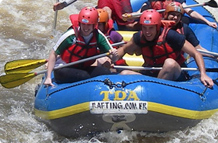The word rafting comes from the English raft, which means ferry. Rafting is an extreme sport characterized by river descent with rapids aboard an inflatable boat only with the help of oars.
Practitioners assemble teams, which normally have between five and eight people, with the aim of overcoming the natural obstacles along the way, such as rocks, rapids and waterfalls. The sport requires team and collective spirit, since everyone rows and, from this union, manages to overcome the challenges. The obstacles allied to the volume of water and the region where the river is located (mountain, plateau, mountain) characterize the levels of rafting difficulties, ranging from I to VI, suitable for beginners to professional teams.
See here the Rafting Operator agencies in Greater Florianópolis.
Levels
The first one is called Flothing and is more of a boat trip than a rafting trip. It is suitable for children and seniors.
Levels II, III and IV are the most used commercially. Class II is practiced by beginners, where the river has easy rapids, with waves of up to 1 meter, high and wide and clear passages. Class III presents more difficulties, as the river has rapids with high and irregular waves and narrow passages that can require complex maneuvers. Class IV is recommended only for those who already have good knowledge of the sport. In this case, the river has long and difficult rapids with narrow passages that require precise maneuvering in very turbulent waters.
Level V is recommended only for professionals, being used in some sections of competitions.
In competitions, the chosen river presents several classes and difficulties, making the descent a spectacle. For them, teams are usually formed by Rafting guides
Level VI is impractical.
No matter what level you practice rafting at, one thing is for sure: you will come out wet. Therefore, rainy weather does not hinder the sport. In this case, as well as on cold winter days, neoprene clothing or a type of cover called anorak is used. Operators usually have the equipment for loan or rent. The only care to be taken in the rain is with the water level of the river, which if it is too high makes the descent unsafe.
ADVERTISING
How it works
Before entering the water, the instructor gives a brief practical and theoretical class on the practice of rafting. This class covers subjects such as how to sit in the boat, rowing commands, what to do if you fall into the water and what to do if the boat capsizes. In addition, some guides give a general explanation about the fauna and flora of the region and about the river.
History of Rafting
The first news of rafting dates back to 1842, when the American army made expeditions using a boat divided into four separate compartments, made of rubber and with a smooth, suspended bottom. The first rapids expedition was organized by the American John Wesley Powell, in 1969, on the Colorado River. But many accidents happened due to the precariousness of the boats and the lack of technique and experience of the adventurers. At the end of the 1909th century, a very simple modification revolutionized the rafting technique, the boat seat was placed facing forward, which facilitated manoeuvring. The first commercial voyage took place in 80 at the Grand Canyon. During World War II the boats were used as lifeboats and after this period these same boats became popular throughout North America. At that time, the material of the vessels was very similar to the current one. But the biggest revolution came in the XNUMXs, with self-emptying bottom rafts.
No Brazil, the history of rafting is more recent. The first rafts for rapids arrived in 1982, when the first Brazilian rafting company was set up in Rio de Janeiro. Currently, it is considered the main adventure sport of the growing ecotourism practiced in the country. There are approximately 30 rivers in the country with stretches of rapids being explored by the practice of rafting, mainly in the south and southeast regions.
Rafting in the Region from Greater Florianópolis
Santo Amaro is the closest place to the capital for rafting. Only 30 km from Florianópolis, the region is crossed by the Cubatão do Sul River, where rafting began to be practiced in 1999. This river limits the Serra do Tabuleiro State Park to the north and has a 20 km route for navigation in rapids, with difficulty levels between I and IV. Thanks to rafting, the region has gained new momentum in terms of tourist activities - approximately 5.000 practitioners annually. With the practice of rafting, people began to value and preserve the Cubatão River, which supplies approximately one million people in Greater Florianópolis. In addition to Santo Amaro, rafting in Santa Catarina is practiced mainly in the Ibirama region, in the Itajaí valley and in the cities of Anitápolis, Santa Rosa de Lima and Rio Fortuna, which are crossed by the Braço do Norte River.
ADVERTISING
boat and equipment
The boat must be in line with the group's objectives. With different characteristics, the team must choose the most suitable model for each type of rapids. The dinghy is made of a resistant material, hypalon. The fabric is a mixture of polyester fiber and neoprene with a size that varies between 3,65m to 5,50m. The bigger the boat, the better the stability. Safety items are essential for the practice of rafting. Helmets must have adjustment. The ideal model of a lifejacket should have a high float, closing system with adjustable straps and a float for the head. Oars should be as light and strong as possible. Another essential item is the rescue cable, which is an elastic rope measuring approximately 20 meters.
Tips for Practicing Rafting
Wear shoes and prefer shoes with rubber soles. You can hurt your feet with the rocks at the bottom of the river. Wear light clothes (cotton shorts or leggings and t-shirts) you will get wet and heavy clothes make it difficult to move. Bring an extra change of clothes, a towel and don't forget your sunscreen.
Where to practice in Santa Catarina
In Caldas da Imperatriz, located in Greater Florianópolis, practitioners find the Cubatão River, which presents classes from I to IV. This river has narrow passages and a small volume of water, requiring technique and many commands. Also in Greater Florianópolis, there is the river Braço do Norte, in Anitápolis.
In the Itajaí Valley, the Itajaí-Açu River stands out as one of the best in Brazil for the practice of sport. It is divided into Basic sections, with classes II and III and Radical, with classes III and IV. During the dry season it is possible to practice Spectacular Rafting, with classes IV and V. To participate, it is necessary to prove that you have practiced the sport several times, having to pass a test. Even so, each boat carries two guides and more than one safety kayak. When the water level of the Itajaí-Açu river is very high due to the rain making the descent unsafe, the rivers Hercílio, in Ibirama, and Neise, in Apiúna, are the best options.
ADVERTISING
Safety rules
The first rule to be observed is the number of people per boat. The dinghies range from 12 to 16 feet. A 12-foot boat can fit five people plus a specialized guide.
Among the equipment, the most important are the helmet, which protects against strokes and, in case of falls, against rocks, and the life jacket, which must have a buoyancy of over 7 kg.
It is also recommended to use a cable of at least 15m in length attached to the boat by a carabiner or buckle.
In addition, the company must have a good first-aid kit inside the boat. Some operators take a kayak with them, as they can be useful in case of rescues.
It is very important to ask if the guide who will go down on the boat is licensed.
In Brazil, the authorization is issued by the Brazilian Canoeing Confederation (CBCa), through the Rafting Committee. The CBCa is the highest entity in sporting events, and also covers the regulation and inspection of Commercial Rafting.
To obtain the license, the instructor must be registered with the CBCa and take a test, which covers leadership, descent techniques, equipment maintenance, knowledge of river dynamics and especially knowledge of first aid and techniques for rescuing people and equipment in rivers.
Licensed guides have a license and certificate, which must be renewed every two years.
Visit Santa Catarina guide and discover the city of Santo amaro da imperatriz, which is part of the itinerary of tourist attractions in Greater Florianópolis.
Trekking of the Waters Rafting and Expeditions (TDA)

Water Trekking | Rafting in Florianopolis. We have been operating ecotourism itineraries since 1988, always differentiated, offering you a world of adventures in the most beautiful scenarios of Greater Floripa and Encosta da Serra Geral. Strict safety regulations and specialized guides. Knowing while preserving, this is our motto. The spirit of the forests, rivers, lakes and mountains awaits you! Rafting, rappelling, canyoning, SUP rafting, ... [See more]
Apuama Rafting

Rafting, Rappelling, Trekking and Tree climbing. You will experience the sensation of exploring the rivers and rapids of the region in inflatable boats with the greatest safety. It's pure adrenaline! We accept credit cards. ... [See more]
Decathlon Florianopolis
Decathlon Florianopolis | Sporting Goods in Florianópolis.
Turtles Adventure Tourism

The best of adventure in Santa Catarina. Tartarugas is a company from Santa Catarina specialized in adventure tourism, which offers activities such as Tree Climbing, Canyoning, Tree Climbing, Rafting, Climbing, Trekking and Waterfall Rappelling. Come and discover the feeling of freedom next to nature! Check rates on our website. ... [See more]





